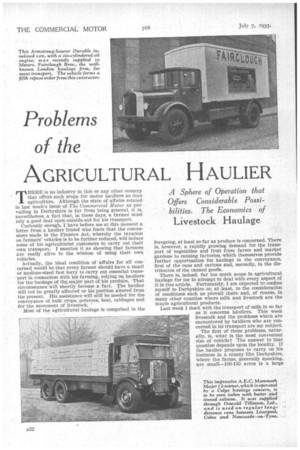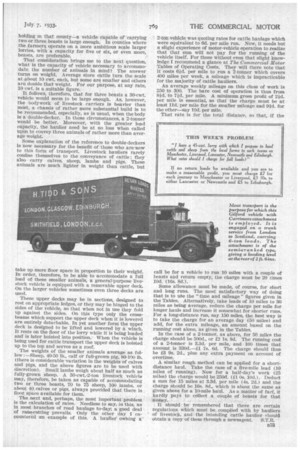Problems of the AGRICULTURAL HAULIER
Page 70

Page 71

If you've noticed an error in this article please click here to report it so we can fix it.
A Sphere of OperatiOn that Offers Considerable Possibilities. The Economics of
Livestock Haulage
THERE is no industry in this or any other country that offers such scope for motor hauliers as does agriculture. Although the state of affairs related in last week's issue of The Commercial Motor as prevailing in Derbyshire is far from being general, it is, nevertheless, a fact that, in these days, a farmer must rely a good deal upon outside aid for his transport.
Curiously enough, I have before me at this moment a letter from a haulier friend who fears that the concessions made in the Finance Act, whereby the taxation on farmers' vehicles is to be further reduced, will induce some of his agriculturist customers to carry out their own transport. I mention it as showing that farmers are really alive to the wisdom of using their own vehicles.
Actually, the ideal condition of affairs for all concerned would be that every farmer should have a small or medium-sized fast lorry to carry out essential trans-port in connection withhis farming, relying on hauliers for the haulage of the major part of his produce. That circumstance will shortly become a fact. The haulier will not be greatly affected or his position altered from the present. His assistance will still be needed for the conveyance of bully crops, potatoes, beet, cabbages and for the movement of livestock. '
Most of the agricultural haulage is comprised in the foregoing, at least so far as produce is concerned. There is, however, a rapidly growing demand for the transport of vegetables and fruit from farms and market gardens to canning factories, which themselves provide further opportunities for haulage in the conveyance, first of the cans and cartons and, secondly, in the distribution of the canned goods.
There is, indeed, far too much scope in agricultural haulage for me to attempt to deal with every aspect of it in this article. Fortunately, I am expected to confine myself to Derbyshire or, at least, to the consideration of conditions such as prevail there and, of course, in many other counties where milk and livestock are the staple agricultural products.
Last week I dealt with the transport of milk in so far as it concerns hauliers. This week livestock and the problems which are encountered by hauliers who are concerned in its transport are my subject.
The first of these problems, naturally, is, what is the most convenient size of vehicle? The answer to that question depends upon the locality. If the haulier proposes to carry on his business in a county like Derbyshire, where the farms, generally speaking, are small-100-150 acres is a large holding in that county—a Vehicle capable of carrying two or three beasts is large enough. In counties where the farmers. operate on a more ambitious scale larger lorries, with a capacity for five or six, or even more, beasts, are preferable.
That consideration brings me to the next question, what is the capacity of vehicle necessary to accommodate the number of animals in mind? The answer turns on weight. Average store cattle turn the scale at about 10 cwt, each, but some are smaller and others are double that weight. For our purpose, at any rate, 10 cwt. is a suitable figure.
It follows, therefore, that for three beasts a 30-cwt. vehicle would seem to be large enough. As, however, the bodywork of livestock carriers is heavier than mast, a chassis of rather more substantial build is to be recommended, especially, as is usual, when the body is a double-decker. In those circumstances, a 2-tonner would be better. Moreover, with the greater load capacity, the haulier need be at no loss when called upon to convey three animals of rather more than average weight.
Some explanation of the reference to double-deckers is now necessary for the benefit of those who are mew to this form of transport. Livestock hauliers rarely confine themselves to the conveyance of cattle ; they also carry calves, sheep, lambs and pigs. These animals are much lighter in weight than cattle, but take up more floor space in proportion to their weight. In order, therefore, to be able to acconamodate a full load of these smaller animals, a general-purpose livestock vehicle is equipped with a removable upper deck. On the larger vehicles sometimes even three decks are used.
These upper decks may be in sections, designed to rest on appropriate ledges, or they may be hinged to the sides of the vehicle, so that when not in use they fold up against the sides. On this type only the crossbeams which support the upper deck when it is lowered are entirely detachable. In yet another form the upper deck is designed to be lifted and lowered by a winch. It rests on the floor of the lorry while it is being loaded and is later hoisted into position. When the vehicle is being used for cattle transport the upper deck is hoisted up to the top and serves as a roof.
The weights of the smaller animals average as follow :—Sheep, 40-50 lb., calf or full-grown pig, 80-100 lb. (there is considerable-variation in the weights of calves and pigs, and the above figures are to be used with discretion). Small lambs weigh about half as much as fully-grown sheep. A 30-cwt.-2-ton livestock vehicle may, therefore, be taken as capable of accommodating two or three beasts, 70 to 75 sheep, 100 lambs, or about 40, calves or pigs, always provided that there is floor. space available for them.
The -next and, perhaps, the most important problem is the ealculation of rates. Needless to say, in this, as in most branches of road haulage to-dar, a good deal of rate-cutting prevails. Only the other day I encountered an example of this. A haulier owning a
2-ton vehicle was quoting rates for cattle haulage which were equivalent to 6d. per mile run. Now, it needs but a slight experience of motor-vehicle operation to realize that that sum will not pay for the running of the vehicle itself. For those without even that slight knowledge I recommend a glance at The Commercial Motor Tables of Operating Costs. They will there note that it costs 6id. per mile to run a 2-tonner which covers 400 miles per week, a mileage which is impracticable for the majority of cattle hauliers.
An average weekly mileage on this class of work is 250 to 300. The bare cost of operation is thus from 8id. to 71d. per mile. A minimum gross profit of aid. per mile is essential, so that the charge must be at least lid, per mile for the smaller mileage and 91d. for the other—say 1.0d. per mile.
That rate is for the total distance, so that, if the call be for a vehicle to run 10 miles with a couple of beasts and return empty, the charge must be 20 times 10d. (16s. 8d.).
Some allowance must be made, of course, for short and long runs. The most satisfactory way of doing that is to uSe the "time and mileage" figures given in the Tables. Alternatively, take leads of 10 miles to 30 miles as being average, reduce the charge per mile for longer hauls and increase it somewhat for shorter runs. For a long-distance run, say 150 miles, the best way is to take the charge for an average day (50 miles) and add, for the extra mileage, an amount based on the running cost alone, as given in the Tables.
In the case of a 2-tonner, as above, for 50 miles the charge should be 500d., or £2 is. 8d. The running cost of a 2-tonner is 3.3d. per mile, and 100 times that amount is 330d.—£1 7s. 6d. The charge should thus be £3 9s. 2d., plus any extra payment on account of overtime.
A similar rough method can be applied for a shortdistance haul. Take the case of a five-mile lead (10 miles of running). Now for a half-day's work (25 miles) the charge would be 250d. (£1 Os. 10d.). Deduct a sum for 15 miles at 3.3d. per mile (4s. 2d.) and the charge should be 16s. 8d., which is about the same as given above for a 10-mile hatl. As a matter of fact, it hardly pays to collect a couple of beasts for that It should be remembered that there are certain regulations which must be complied with by hauliers of livestock, and the intending cattle haulier should obtain a copy of them through a newsagent. S.T.R.




































































































